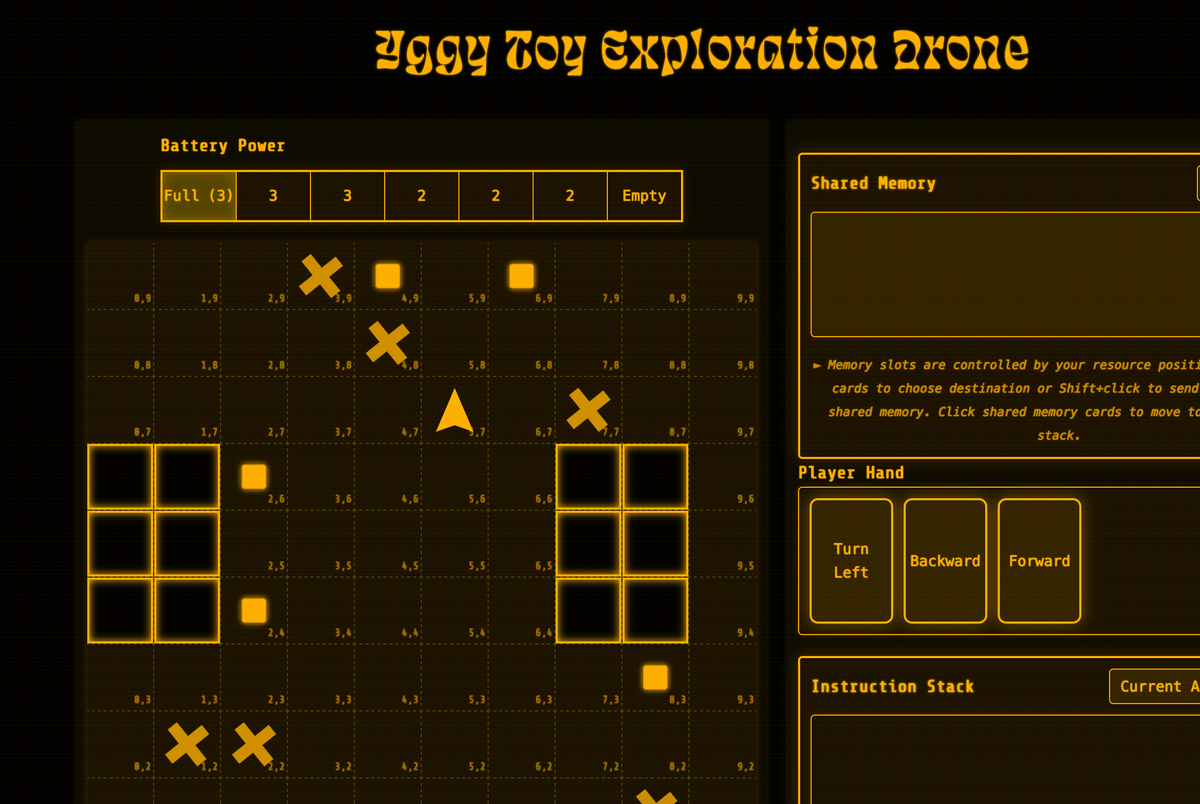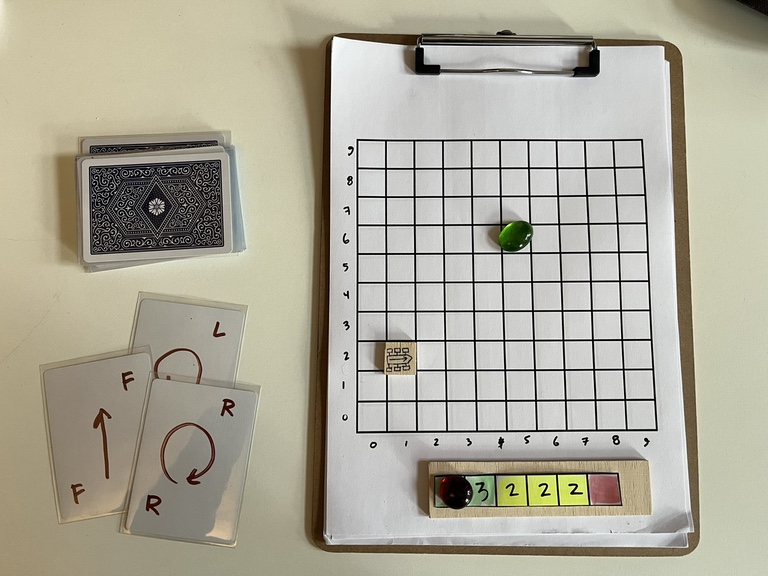I Built a Programmed Movement Game
And it seems decent enough to share

In this post I’d like to explore a small programmed movement game that I built. The game is single-player and browser-based; I invite you to give it a try if you’re interested.
It actually was a board game idea
In December of last year, I attended a local meetup for board game designers and playtesting. One of the games that we played that night was a racing game, in which players used turn-based programmed movement to circle a track. In a lot of ways, the game was similar to Flamme Rouge. Movement cards allow you to move forward or switch lanes, and that was layered with other pick ups and effects to make the game a bit more exciting.
Thanks for reading Playful Work! Subscribe for free to receive new posts and support my work.
That version of the game we played had an issue or two with how the programmed movement worked. I don’t recall what they were, and I’m sure they’ve since been fixed, but the important point is that it got me thinking about how I might do a programmed movement design. On the train ride home, I hatched an idea for a simple game where players use cards to collaborate on programmed movement for the same vehicle, but with an extra catch: the cards get played into a stack, and the rover executes the cards last-in-first-out (LIFO), starting with the top card in the stack and playing each card beneath it in turn.
The other inspiration was The Crew, which we had been playing a lot with some family in town. I really liked the idea of limited communication in a co-op game, so it was top of mind.
Because of this, I think the fiction of a planetary rover was always part of the design–I imagined two 1960s era programmers in a NASA command center trying to control a small robot on a faraway planet, using only a blip on a screen and a limited instruction set. The LIFO constraint fit the idea of old school programming, and was a fun constraint to make things a bit different.

To play, you place a small token representing the rover on a 10x10 grid, along with a randomly determined target square. Two players draw from a deck of cards small hands with movement instructions for the rover. The players then take turns placing the cards into the stack or shared memory. Instead of placing a card, a player can also use their turn to “execute the stack.” When this happens all movement cards on the stack are executed from top to bottom, and one of the rover’s battery charges is used.
That’s pretty much the core idea. Since the cards are played in LIFO order, it restricts your ability to completely plan the routes in advance, and gives the game a small press-your-luck element due to having to start your planning with the moves you think you’re going to make last. The resource management with the battery gives players the chance to use multiple stack executions to reach the target, but makes the total number of executions limited.
Deciding to make it digital
I playtested the board game a few times and had pretty good results. The game was not for everyone, but some folks really enjoy puzzling out the backwards planning.
The main issue I encountered was setting up some variety in the maps and keeping the goals interesting. Originally, the goal was just to use the rover to pick up 3 randomly placed resources. While this works, it can get a little stale, and once players get good at moving the rover, it’s actually not that hard to complete the goal on almost every run.
At this point, I felt the game needed more variety in both the difficulty and the player goals. I didn’t really want to design and print out a pile of maps (although I still might!) and it seemed a bit onerous to roll dice to set up the game with lots of random hazards and pick-ups. So, I fed the rules to Claude, and asked it build an HTML map generator.
Since I had already written the rules of the game and the scope was small, Claude’s output was pretty good. In less than an hour, I had a barebones map generator that made setting up the game much easier.
But why stop there? I may as well have a way to play the maps if I’m going to generate them, right? So, I cajoled, hand-slapped, and sometimes “vibed” Claude some more to make the game playable with a single player. Despite the theme of the game, this is not mission critical code, and I don’t care too much if it breaks. This led to a workable prototype after just a couple days.
Getting to fun in single player mode
Because the prototype was pretty fun, it was easy to keep investing a day here and there into improvements. Over the course of a month or two, I added:
- A scoring system for single player.
- Random and pre-generated maps.
- Additional “deadly” hazards to give the maps better identity and increase the stakes a bit. A “deadly” hazard causes the game to end if you collide with it.
- Updates to the aesthetic (amber CRT) and a weirder, post-apocolyptic backstory.
- Tutorials (which are still a work in progress).
- An “endless” or high-score mode.
The endless mode and scoring system are what really made it start to feel like a proper single player game. In endless mode, you play level-by-level, with each level increasing in difficulty (more hazards, more stringent requirements). The levels alternate between maps that I’ve created and randomly generated maps, but the resource and drone placement are always random. Combining this with the variance of the cards makes the maps different enough to be replayable, at least in the context of having around 50 different maps already.
All-in-all, the digital version of the game probably has about 2 weeks of full-time work invested. Not bad!
What now?
I think the game is decent, but has a ton of room to improve–in particular the player onboarding and UX could be much better. Building the tutorials is both challenging but super important. I think that a lot of players might bounce from the game before getting to success, because LIFO is a bit counter-intuitive and obtuse. However, it’s also a big part of the game’s positive “brain feels”–when you start to get it right it’s really statisfying as a player. So, yeah, it’s super important for this game to onboard players gently, and I’m not doing a great job of that yet.
There are a ton of directions the game’s mechanics could go, for example:
- Deckbuilding and drafting (I might be a little ‘meh’ on this, not sure that it’s needed, but maybe there could be a couple card power-ups).
- Environmental effects. This would be an effect that impacted all play for a level, like, e.g. “Easterly winds: move rover one additional square east after executing the stack.” (I’m interested in this, but need to playtest the right effects).
- Leaderboards and daily puzzles.
What I actually could use most right now, though, is feedback…
Wanna playtest?
I need playtesters and feedback! If the game sounds interesting to you, please give it a try! Here’s the link again:
If there’s something you think is terrible or great, let me know, I’d love to talk to you about it! I can be reached via email at “hello” at liminal.games. I’m also @hdh.me on Bluesky.
Thanks for reading Playful Work! Subscribe for free to receive new posts and support my work.